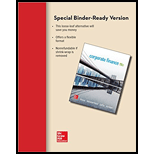
WACC Bolero, Inc., has compiled the following information on its financing costs:

The company is in the 35 percent tax bracket and has a target debt-equity ratio of 60 percent. The target short-term debt/long-term debt ratio is 20 percent.
- a. What is the company’s weighted average cost of capital using book value weights?
- b. What is the company’s weighted average cost of capital using market value weights?
- c. What is the company's weighted average cost of capital using target capital structure weights?
- d. What is the difference between WACCs? Which is the correct WACC to use for project evaluation?
a.
To determine: The Company’s Weighted Average Cost of Capital using Book Value Weights.
Introduction: Beta is the risk related with a portfolio or a security in connection to the market. It is also termed as the beta coefficient; it is a method for deciding on the requirement on security or stock that may move in contrast with the market. Leverage is a method that increases profits or losses of the shareholders. It is usually used to illustrate the utilization of funds borrowed to increase income prospective or financial leverage. However it can also explain the use of fixed assets to accomplish the similar objectives.
Answer to Problem 9QP
The Company’s Weighted Average Cost of Capital using Book Value Weights is 6.09%.
Explanation of Solution
Determine the Weight of Short-Term Debt
Therefore the Weight of Short-Term Debt is 0.2927
Determine the Weight of Long-Term Debt
Therefore the Weight of Long-Term Debt is 0.4878
Determine the Weight of Equity
Therefore the Weight of Equity is 0.2195
Determine the Weighted Average Cost of Capital using Book Value Weights
Therefore the Weighted Average Cost of Capital using Book Value Weights is 6.09%
b.
To determine: The Company’s Weighted Average Cost of Capital using Market Value Weights.
Answer to Problem 9QP
The Company’s Weighted Average Cost of Capital using Market Value Weights is 9.90%.
Explanation of Solution
Determine the Weight of Short-Term Debt
Therefore the Weight of Short-Term Debt is 0.1397
Determine the Weight of Long-Term Debt
Therefore the Weight of Long-Term Debt is 0.2570
Determine the Weight of Equity
Therefore the Weight of Equity is 0.6034
Determine the Weighted Average Cost of Capital using Market Value Weights
Therefore the Weighted Average Cost of Capital using Market Value Weights is 9.90%
c.
To determine: The Company’s Weighted Average Cost of Capital using Target Capital Structure Weights.
Answer to Problem 9QP
The Company’s Weighted Average Cost of Capital using Target Capital Structure Weights is 10.25%.
Explanation of Solution
Determine the Value of Debt
Therefore the Value of Debt is 37.5%
Determine the Value of Equity
Therefore the Value of Equity is 62.5%
Determine the Weight of Short-Term Debt of Total Debt
Therefore the Weight of Short-Term Debt of Total Debt is 0.1667
Determine the Weight of Long-Term Debt of Total Debt
Therefore the Weight of Long -Term Debt of Total Debt is 0.8333
Determine the Weight of Short-Term Debt
Therefore the Weight of Short-Term Debt is 6.25%
Determine the Weight of Long-Term Debt
Therefore the Weight of Long-Term Debt is 31.25%
Determine the Weighted Average Cost of Capital using Target Capital Structure Weights:
Therefore the Weighted Average Cost of Capital using Target Capital Structure Weights is 10.25%
d.
To determine: The Difference between WACC and the appropriate WACC to use for project evaluation.
Explanation of Solution
The difference between WACC and the appropriate WACC to use for project evaluation is as follows:
The difference in WACC between the three weights is based on the diverse weights. The WACC of the company is equally look like the WACC estimated by using target weights as the project will be financed under the target ratio. Hence, the WACC calculated using target weights should be considered for project evaluation.
Want to see more full solutions like this?
Chapter 18 Solutions
CORPORATE FINANCE (LL)-W/ACCESS
- Brower Co. is considering the following alternative financing plans: Income tax is estimated at 40% of income. Determine the earnings per share of common stock, assuming that income before bond interest and income tax is 2,000,000.arrow_forwardA company had WACC (weighted average cost of capital) equal to 8. % If the company pays off mortgage bonds with an interest rate of 4% and issues an equal amount of new stock considered to be relatively risky by the market, which of the following is true? a. residual income will increase. b. ROI will decrease. c. WACC will increase. d. WACC will decrease.arrow_forwardOgier Incorporated currently has $800 million in sales, which are projected to grow by 10% in Year 1 and by 5% in Year 2. Its operating profitability ratio (OP) is 10%, and its capital requirement ratio (CR) is 80%? What are the projected sales in Years 1 and 2? What are the projected amounts of net operating profit after taxes (NOPAT) for Years 1 and 2? What are the projected amounts of total net operating capital (OpCap) for Years 1 and 2? What is the projected FCF for Year 2?arrow_forward
 EBK CONTEMPORARY FINANCIAL MANAGEMENTFinanceISBN:9781337514835Author:MOYERPublisher:CENGAGE LEARNING - CONSIGNMENT
EBK CONTEMPORARY FINANCIAL MANAGEMENTFinanceISBN:9781337514835Author:MOYERPublisher:CENGAGE LEARNING - CONSIGNMENT
 Intermediate Financial Management (MindTap Course...FinanceISBN:9781337395083Author:Eugene F. Brigham, Phillip R. DavesPublisher:Cengage Learning
Intermediate Financial Management (MindTap Course...FinanceISBN:9781337395083Author:Eugene F. Brigham, Phillip R. DavesPublisher:Cengage Learning Cornerstones of Cost Management (Cornerstones Ser...AccountingISBN:9781305970663Author:Don R. Hansen, Maryanne M. MowenPublisher:Cengage Learning
Cornerstones of Cost Management (Cornerstones Ser...AccountingISBN:9781305970663Author:Don R. Hansen, Maryanne M. MowenPublisher:Cengage Learning





